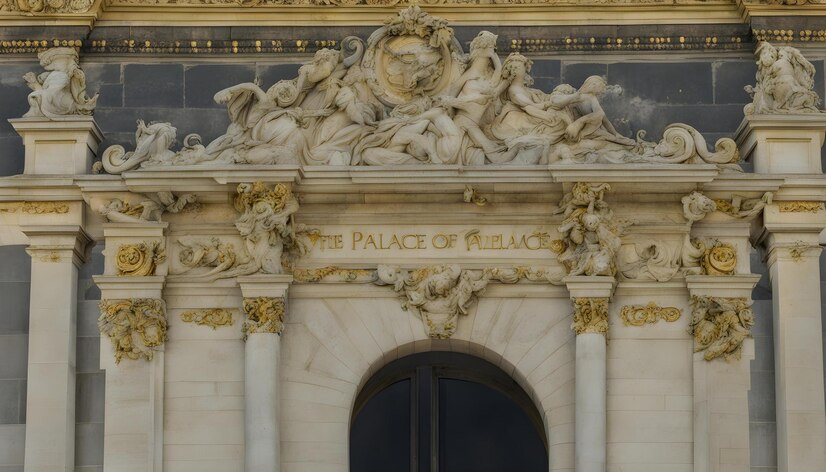Step into the world of architectural elegance and grandeur as we delve into the fascinating realm of pilasters. These timeless elements have adorned buildings for centuries, adding a touch of sophistication and charm to facades worldwide. Join us on this captivating journey as we explore the intricate beauty and design possibilities that pilasters offer in the world of architecture.
Understanding Pilasters
Pilasters are architectural features that resemble columns, but they are flat against a wall rather than freestanding. They serve both decorative and structural purposes, adding depth and visual interest to buildings. These vertical elements often feature ornate detailing such as fluting, scrollwork, or intricate carvings, enhancing the overall aesthetic of a structure.
Unlike columns which support weight independently, pilasters typically provide decoration or frame openings like doors and windows. While they may not have the load-bearing functionality of columns, pilasters play a crucial role in defining the style and character of a building’s design. Their presence can evoke a sense of classical elegance or add a touch of sophistication to modern architecture.
Whether adorning the exterior facade of grand buildings or embellishing interior spaces with flair, pilasters remain an enduring symbol of architectural finesse and craftsmanship.
Illustration of a Pilaster
Pilasters are architectural elements that resemble flat columns or pillars, typically found on the facades of buildings. Imagine a rectangular vertical shape protruding slightly from the wall, adding depth and dimension to the structure.
Illustrating a pilaster in its simplest form involves envisioning a vertical element with a base at the bottom, often adorned with decorative details like fluting or scrollwork. At the top, there’s usually a capital resembling that of classical columns – think Ionic or Corinthian styles.
When looking at an illustration of a pilaster, you’ll notice how it can create visual interest and symmetry in architecture. Whether used singly as an ornamental feature or in pairs framing doorways and windows, pilasters add elegance and sophistication to any building design.
Synonyms
When it comes to architectural elements, pilaster’s are known by different names across various design styles. Synonyms for pilasters include ‘false columns,’ ‘engaged columns,’ or even ‘wall pillars.’ These terms all refer to the same structural element that resembles a flattened column protruding from a wall.
The use of synonyms reflects the diverse influences and interpretations of pilaster’s in architecture throughout history. Whether referred to as engaged columns or false columns, these vertical supports play a significant role in defining the visual appeal and structural integrity of buildings.
Understanding these alternate terms can provide insights into how different architectural traditions have incorporated pilasters into their designs. By exploring these synonyms, designers and enthusiasts alike can deepen their appreciation for the versatility and timeless beauty of this classic architectural feature.
Examples of Pilasters in Architecture
In architecture, pilaster’s are versatile elements that can be found in various styles and periods. One iconic example of their use is in neoclassical buildings, where they often flank doorways or windows to add a touch of sophistication.
In Renaissance architecture, pilaster’s were frequently incorporated into the design of churches and palaces, enhancing the overall grandeur of the structures. These decorative columns served both aesthetic and structural purposes, showcasing intricate detailing and craftsmanship.
During the Baroque period, pilaster’s continued to be prominent features in architectural designs. They could be seen adorning facades, creating a sense of visual interest and symmetry. The elaborate carvings on these pilaster’s added a sense of opulence to buildings.
Fast forward to modern times, where architects still draw inspiration from classical elements like pilaster’s . Contemporary structures may feature sleek and minimalist interpretations of these traditional columns, blending seamlessly with modern aesthetics while paying homage to architectural history.
Word History
Have you ever wondered about the origins of the term “pilaster”? The word history of pilasters traces back to ancient Roman architecture, where these decorative elements were widely used to mimic the appearance of structural columns. Derived from the Latin word “pila,” meaning pillar or column, pilasters have evolved over centuries as a prominent feature in various architectural styles.
The use of pilasters continued through different periods and cultures, adapting to reflect changing design aesthetics and preferences. From classical Greek influences to Renaissance and Baroque styles, pilasters have remained a versatile element in architectural design.
Today, architects and designers continue to draw inspiration from historical references when incorporating pilasters into modern structures. Whether used for ornamental purposes or structural support, the rich word history of pilasters adds depth and character to any architectural composition.
In Classical Architecture
In classical architecture, pilasters play a significant role in defining the style and character of a building. These flattened columns are often used decoratively on facades to create depth and add visual interest. The use of pilasters can be traced back to ancient civilizations like Greece and Rome, where they were incorporated into temples, palaces, and public buildings.
One iconic example of pilasters in classical architecture is the Pantheon in Rome, where Corinthian pilasters adorn the exterior of the building. These architectural elements not only serve an aesthetic purpose but also provide structural support to the overall design.
Throughout history, architects have continued to draw inspiration from classical architecture when designing new structures. Whether it’s incorporating Doric or Ionic order pilasters into a facade or experimenting with different materials and finishes, the influence of classical design remains prevalent in modern-day buildings.
Definition
Pilasters, a striking architectural element that often goes unnoticed. But what exactly is a pilaster? In simple terms, it’s a flat column-like structure projecting from a wall, typically with a base, shaft, and capital. This decorative feature serves both aesthetic and structural purposes in design.
Unlike columns that are freestanding, pilasters are attached to walls for added visual interest and support. They can be found on exteriors and interiors of buildings, adding depth and dimension to facades or rooms.
In classical architecture, pilasters were commonly used alongside columns in various orders like Doric, Ionic, or Corinthian. Their versatility allows them to adapt to different styles and periods while maintaining their unique character.
Whether you’re designing a contemporary space or restoring a historic building, incorporating pilasters can elevate the overall look and feel of your project. Their timeless appeal adds sophistication and charm to any architectural composition.
Types of Pilasters
Pilasters come in various types, each adding its unique charm to architectural designs. Residential pilaster’s , often found in homes and buildings, serve both decorative and structural purposes. These pilaster’s can be crafted from materials like wood or stone, enhancing the overall aesthetic appeal of a structure.
Ionic Order Pilasters showcase intricate details inspired by ancient Greek architecture. Their elegant fluting and ornate capitals exude timeless sophistication. Federal Style Exterior Door c. 1800 features pilaster’s with delicate moldings and clean lines that reflect the neoclassical design trends of the period.
Designers often combine columns with pilasters to create visually dynamic spaces that evoke a sense of grandeur. Interior pilasters have evolved through the centuries, adapting to different design styles while maintaining their classic appeal.
There is a wide range of options when it comes to utilizing pilaster’s in projects, from traditional materials like wood to modern alternatives such as PVC or polyurethane for specific project needs.
Residential Pilasters
Residential pilasters are architectural elements that can add a touch of elegance and sophistication to any home. These vertical columns often mimic the appearance of classical Greek or Roman pillars, giving a sense of grandeur to residential facades.
In traditional architecture, residential pilasters are commonly used to frame doorways or windows, creating a sense of symmetry and balance in the design. They can also be seen as decorative accents on exterior walls, adding visual interest and depth to the overall aesthetic.
One popular way to incorporate residential pilasters is by using them in conjunction with other architectural features such as cornices or pediments. This combination can create a cohesive look that ties together different elements of the building’s facade.
Whether you prefer a more traditional or modern style, residential pilasters offer versatility in design choices. From simple and understated designs to intricate and ornate details, these architectural elements can elevate the curb appeal of any home.
Federal Style Exterior Door c. 1800
Step back in time to the early 19th century and envision a Federal style exterior door from around 1800. This architectural gem showcases the elegance and sophistication of the period, with intricate details and symmetrical design elements that are truly captivating. The pilasters flanking the doorway add a touch of grandeur, emphasizing the vertical lines and creating a sense of balance.
Crafted with precision and attention to detail, these pilasters not only serve as decorative features but also provide structural support for the entrance. The smooth surfaces of the pilasters contrast beautifully with any ornate moldings or trim work adorning the door frame, making them stand out even more.
The Federal style exterior door c. 1800 is a true testament to the timeless allure of classical architecture. Its understated yet refined aesthetic continues to inspire designers and architects today, showcasing how historical elements like pilasters can elevate modern-day projects with a touch of historic charm.
Combining Columns and Pilasters
When it comes to architectural design, the combination of columns and pilasters can create a striking visual impact. The juxtaposition of these elements adds depth and dimension to a structure, enhancing its overall aesthetic appeal.
Columns provide structural support while pilasters serve as decorative elements that help define the style of a building. By integrating both features, architects can achieve a harmonious balance between form and function.
Whether used in exterior facades or interior spaces, the marriage of columns and pilasters offers endless design possibilities. From classical Greek-inspired motifs to more contemporary interpretations, this pairing allows for creative experimentation with architectural composition.
The contrast between the solid presence of columns and the flat relief of pilasters creates an interesting interplay of light and shadow, adding texture and complexity to architectural facades. This dynamic relationship enriches the visual storytelling within a space, captivating viewers with its timeless elegance.
Interior Pilasters through the Centuries
Interior pilasters have played a significant role in interior design throughout the centuries. From ancient Roman times to modern-day architecture, these structural elements have added elegance and sophistication to various interiors. In classical buildings, pilasters were often used to create a sense of grandeur and symmetry within spaces.
During the Renaissance period, interior designers embraced pilaster’s as decorative features that showcased intricate detailing and craftsmanship. The Baroque era saw an increase in the use of ornate pilaster’s with elaborate carvings and embellishments adorning palaces and churches.
In more recent times, interior designers continue to incorporate pilaster’s into their designs to add depth and architectural interest to rooms. Whether used as standalone elements or integrated with other architectural features, interior pilaster’s remain timeless additions that elevate the aesthetic appeal of any space.
Utilizing Pilasters in Projects
Pilasters are versatile architectural elements that can elevate the design of any project. When utilized strategically, pilasters can add depth and dimension to both interior and exterior spaces. In projects ranging from residential homes to commercial buildings, pilasters offer a timeless aesthetic appeal that transcends trends.
In modern construction projects, PVC or polyurethane pilaster’s are popular choices due to their durability and cost-effectiveness. These materials allow for intricate designs while being low-maintenance, making them ideal for various project needs.
Whether accentuating a grand entrance or adding sophistication to an interior space, pilasters provide a classic touch that never goes out of style. By incorporating these architectural features into your projects, you can achieve a refined look that exudes elegance and charm.
From traditional to contemporary styles, the versatility of pilasters allows for endless creative possibilities in architectural design. Whether used as standalone elements or in combination with columns, pilasters bring character and visual interest to any project they adorn.
PVC or Polyurethane Pilasters for Specific Project Needs
PVC or polyurethane pilasters offer a versatile solution for various project needs. These materials provide durability and resistance to elements, making them ideal for both interior and exterior applications. PVC pilasters are lightweight and easy to install, perfect for DIY enthusiasts looking to enhance their home’s aesthetic appeal.
Polyurethane pilasters mimic the look of traditional materials like wood or stone but with added benefits such as being maintenance-free and cost-effective. Whether you’re renovating a historic property or designing a modern space, PVC or polyurethane pilasters can elevate the architectural details of your project effortlessly.
With a wide range of styles and finishes available in PVC or polyurethane options, you can easily find a design that suits your specific project requirements. From classic to contemporary, these pilaster’s offer endless possibilities for enhancing the beauty and charm of any structure.
Conclusion
Pilasters are not just architectural elements but timeless pieces that add depth and sophistication to any building. From ancient Greek temples to modern residential homes, pilasters continue to be a design choice that stands the test of time. Understanding the history, types, and ways to incorporate pilaster’s into projects can elevate the aesthetic appeal of any structure. Whether it’s using PVC or polyurethane for specific project needs or combining columns with pilaster’s for a classic look, these versatile features offer endless possibilities for creativity in architecture and design. So next time you admire a beautifully designed building facade or interior space, take a closer look – there might just be some elegant pilaster’s enhancing its beauty.
Should you wish to explore other topics, head to our main blog. We’ve got more!







